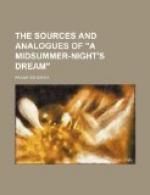INDEX 194
* * * * *
The sources and analogues
of
“A midsummer-night’s dream”
A study such as the present one does not demand any elaborate investigation of the date or circumstances of the first production of the play, unless these throw light on the inquiry into its sources; but in any case it is always well to base a literary study on literary history. Here it will suffice to say shortly that A Midsummer-Night’s Dream, first published in 1600, must have been acted before or during 1598, as it is definitely mentioned in Mores’ Palladic Tamia of that year. A more exact determination of its date can only be derived from the internal evidence supplied by allusions in the text or by metrical and general style. Such allusions as have been discovered—for example, that reference to “the death of learning,” V. i. 52-3—form here as elsewhere a battle-ground for critics of all sorts, but do not really assist us to an answer. More trustworthy testimony, however, is afforded by the general character of the play, and by Shakespeare’s handling of his material; these considerations, combined with whatever other evidence is available, have caused the play to be assigned to the winter of 1594-5. So placed, it is the latest of the early comedies of Shakespeare, who makes an advance on The Two Gentlemen of Verona, but has not yet attained the firmness of hand which fills the canvas of The Merchant of Venice with so many well-delineated figures. Once arrived at this conclusion, we need not let ourselves again be led away into vagueness or critical polemics by an attempt to find any aristocratic wedding which this masque-like play seems designed to celebrate; such theorising, however interesting in other ways, does not concern and will not avail us now.
It is none the less of value to recognise at the outset that A Midsummer-Night’s Dream is more of a masque than a drama—an entertainment rather than a play. The characters are mostly puppets, and scarcely any except Bottom has the least psychological interest for the reader. Probability is thrown to the winds; anachronism is rampant; classical figures are mixed with fairies and sixteenth-century Warwickshire peasants. The main plot is sentimental, the secondary plot is sheer buffoonery; while the story; of Titania’s jealousy and Oberon’s method of curing it can scarcely be dignified by the title of plot at all. The threads which bind together these three tales, however ingeniously fastened, are fragile. The Spirit of Mischief puts a happy end to the differences of the four lovers, and by his transformation of Bottom reconciles the fairy King and Queen, while he incidentally goes near to spoiling the performance of the “crew of patches” at the nuptials of Theseus by preventing due rehearsal




